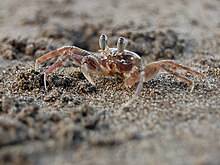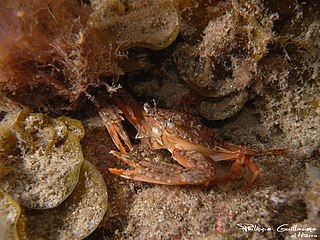
Portunus is a genus of crabs which includes several important species for fisheries, such as the blue swimming crab and the Gazami crab. Other species, such as the three-spotted crab are caught as bycatch.

Ghost crabs are semiterrestrial crabs of the subfamily Ocypodinae. They are common shore crabs in tropical and subtropical regions throughout the world, inhabiting deep burrows in the intertidal zone. They are generalist scavengers and predators of small animals. The name "ghost crab" derives from their nocturnality and their generally pale coloration. They are also sometimes called sand crabs, though the name refers to various other crabs that do not belong to the subfamily.

Ocypode is a genus of ghost crabs found in the sandy shores of tropical and subtropical regions throughout the world. They have a box-like body, thick and elongated eyestalks, and one claw is larger than the other in both males and females. They inhabit deep burrows in the intertidal zone. They are primarily nocturnal, and are generalist scavengers and predators of small animals. The genus contains 21 species.

Eriocheir is a genus of crabs, including the Chinese mitten crab, E. sinensis. Formerly in the family Grapsidae, it is now placed in the Varunidae.
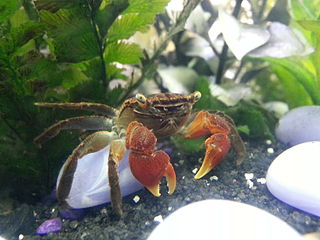
Perisesarma bidens, the red claw crab, is a species of crab found in the Indo-Pacific region from Zanzibar to Japan and Fiji.
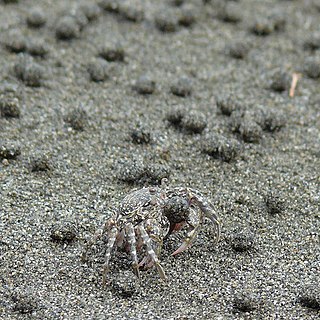
Sand bubbler crabs are crabs of the genera Scopimera and Dotilla in the family Dotillidae. They are small crabs that live on sandy beaches in the tropical Indo-Pacific. They feed by filtering sand through their mouthparts, leaving behind balls of sand that are broken up by the incoming high tide.

Hemigrapsus sanguineus, the Japanese shore crab or Asian shore crab, is a species of crab from East Asia. It has been introduced to several other regions, and is now an invasive species in North America and Europe. It was introduced to these regions by ships from Asia emptying their ballast tanks in coastal waters.

Helice tridens is a species of crab which lives on mudflats around the coasts of Japan and the Korean Peninsula.

The Atlantic ghost crab, Ocypode quadrata, is a species of ghost crab. It is a common species along the Atlantic coast of the United States, where it is the only species of ghost crab; its range of distribution extends from its northernmost reach on beaches in Westport, Massachusetts, south along the coasts of the tropical Western Atlantic Ocean to the beach of Barra do Chui, in Rio Grande do Sul in southern Brazil.

Ocypode ceratophthalmus, the horned ghost crab or horn-eyed ghost crab, is a species of ghost crab. It lives in the Indo-Pacific region ; from the coast of East Africa to the Philippines and from Japan to the Great Barrier Reef. They also occur in the Pacific Islands to as far east as Polynesia and Clipperton Island. As their common name implies, O. ceratophthalmus possess eyestalks extending beyond the eyes into long points, which are longer in adults, and shorter in juveniles. The crabs have a box-shaped body, 6–8 centimetres (2.4–3.1 in) across the carapace, with a darker markings towards the rear in the shape of an H. The outer edges of the eye-sheaths are also sharp and broadly triangular and distinctly pointing sideways in larger individuals. O. ceratophthalmus can run at speeds of up to 2.1 metres per second (6.9 ft/s).

Actumnus is a genus of crabs in the family Pilumnidae. Alongside the 28 extant species, it has a fossil record extending back into the Miocene.

Hemigrapsus is a genus of varunid crabs comprising thirteen species native almost exclusively in the Pacific Ocean, but two have been introduced to the North Atlantic region.

Liagore is a genus of crabs in the family Xanthidae, native to Australia, containing the following species:

Atergatis is a genus of crabs in the family Xanthidae, containing the following species:
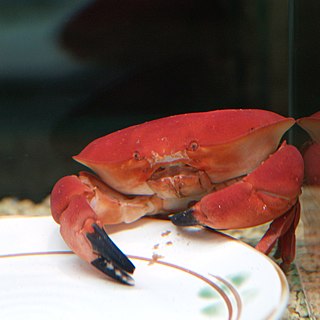
Atergatis subdentatus, also known as the red reef crab, dark-finger coral crab or eyed coral crab, is a species of crab in the family Xanthidae.

Ocypode africana, commonly known as the African ghost crab, is a species of ghost crabs native to the eastern Atlantic coast of western Africa, from Mauritania to Namibia. They are medium-sized ghost crabs reaching carapace width of 3.4 cm (1.3 in). They can vary in coloration from pinkish to dark grey. They are one of only two ghost crab species found in the eastern Atlantic. However, African ghost crabs can easily be distinguished from tufted ghost crabs by the absence of long tufts of hair on the tip of their eyestalks.

Ocypode convexa, commonly known as the golden ghost crab, or alternatively the western ghost crab or yellow ghost crab, is a species of ghost crabs endemic to the coast of Western Australia, from Broome to Perth. They are relatively large ghost crabs, with a carapace growing up to 45 mm (1.8 in) long and 52 mm (2.0 in) wide. They are easily recognisable by their golden yellow colouration. Like other ghost crabs they have box-like bodies with unequally sized claws. They also have large eyestalks with the cornea occupying most of the bottom part.
Halimede is a genus of crabs in the family Galenidae, with species occurring in Australia, Africa, and China.

Macrophthalmus japonicus, the Japanese mud crab, is a species of sentinel crab in the family Macrophthalmidae found in Asia. The taxon was described by Wilhem de Haan in 1835.
Ocypode saratan, also known as the Red Sea ghost crab, is a medium to large-sized species of Ocypode found in the Red Sea. Very common species in the Red Sea, and one of only two species known from there. Also known from Madagascar through Indian Ocean to the Western Pacific. Their eyestalks possess styles.
